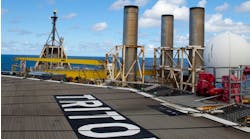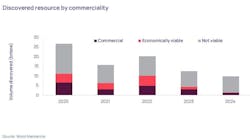Offshore staff
DHAHRAN, Saudi Arabia – Saudi Aramco has started production from Karan, its first non-associated gas field development.
Gas began flowing earlier this month and is being transported via a 110-km (68-mi) subsea pipeline for processing at the onshore Khursaniyah Gas Plant.
Offshore facilities comprise five production platform complexes connected to a main tie-in platform equipped with electrical power, communication, and remote monitoring and control facilities. Detailed design work began in March 2009.
Karan was discovered in April 2006 in 40-60 m (131-107 ft) water depth off eastern Saudi Arabia, 160 km (99 mi) north of Dhahran. The Karan-6 well, drilled into Khuff formations, found gas in carbonate reservoirs from Permian and Triassic intervals.
Its Khuff’s reservoir section is the thickest encountered to date in Saudi Arabia, with gross thickness of up to 1,000 ft (305 m). The Khuff formation ranges in depth from 10,500-13,700 ft (3,200-4,176 m).
At Khursaniyah, the gas is processed through trains with facilities for gas sweetening, acid-gas enrichment, gas dehydration, and supplementary propane refrigeration.
The onshore facilities also include a cogeneration plant, a sulfur recovery unit with storage tank, substations, and a transmission pipeline linked to the Kingdom’s Master Gas System (MGS).
Karan’s development is designed to produce 1.8 bcf/d of raw, dry gas by 2013 from 21 increment wells spread around five wellhead platforms.
Five wells have been commissioned so far from one platform, each producing 120 MMcf/d. Drilling is under way on 14 more wells on three other platforms, with only four wells remaining to be drilled.
These wells will be completed, tied in and put onstream by June 2012 at1.5 bcf/d. The remaining two wells and platform should be ready in April 2013, taking Karan up to its full production capacity of 1.8 bcf/d.
Development involved local construction contractors, fabrication shops and engineering consultants, subcontracted by major global engineering, procurement and construction contractors. Early in the program, local design offices performed engineering studies in preparation for the detailed design.
Much of the equipment was fabricated in Saudi Arabia. This includes high-pressure vessels and injection skids to fusion epoxy pipe coating. Much of the construction work for the Khursaniyah plant was also managed by local contractors, including site preparation, pipe welding and installation, and electrical substation building.
07/27/2011


